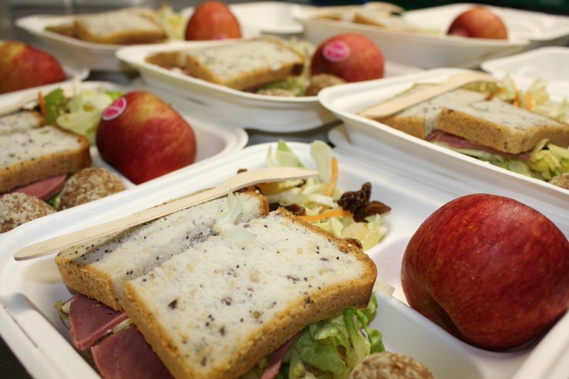
Experts within the health and education sectors have expressed their doubt over whether the Government's newly packaged school lunches programme will meet children's needs, despite its promise to save millions of dollars and feed more children.
The new-look programme was announced by Associate Health Minister David Seymour yesterday. He confirmed the plan will continue as normal for children in Years 0 to 6, and offer sandwiches and fruit for children in Years 7 and above.
Seymour also announced a new targeted programme for kids between 2 and 5 years old in the poorest, community-run education centres. He believes the programme's new format will save the country $107 million.
The key to the money saved is bulk buying - the Government plans to bulk purchase packaged sandwiches and fruit for children eligible for the programme. Seymour stood by his plan on Newstalk ZB this morning.
"The scheme we have introduced is going to be putting the same sorts of items in front of kids in schools that are put in the lunchboxes of the other 75 per cent of students in New Zealand who aren't eligible for the programme," he said.
"The idea that that's somehow neglectful is somewhat offensive to all those other parents and students."
Yet the blowback against his proposed changes has come from the health and education sectors with experts unsure the plan will deliver what is promised.
Talking to the Mike Hosking Breakfast this morning, Boyd Swinburn of the Health Coalition Aotearoa said he would rank the programme a four out of ten.

"At least we have it going for another couple of years, but you just wanted to pull one hundred million out in what he's calling savings, but ’really a withdrawal of investment into what is the biggest nutrition child intervention we've ever had in this country," he said.
"We're doing nothing otherwise about the problems we've had in the childhood [sector] - with child obesity, rotten teeth, with poor mental health and so on, so this is going to be a big blow and I think the schools are going to be really struggling to put it together; it’s a huge amount out [gone]."
Hosking said you could not argue with more kids getting fed, but Swinburn was suspicious of the minister's claims.
"He's dropping the amount coming to those high school and intermediate kids from 160-odd million down to 50m and still have the same quality, still have the same results - that is a big call," he said.
The maths behind bulk-buying didn't convince Swinburn that the programme would be effective. He said the current school programme has quite strong nutrition standards to uphold and he was sceptical the other programme has that.
"This is a huge pull of funding [from] what is a major programme that the schools appreciate. It's doing its job, it's alleviating hunger in schools, it's improving health and nutrition in kids, it's a contribution to local jobs and if they pull the programme the jobs will go for sure," he said.
Hosking pointed out the bottom line of Seymour's strategy was to put fruit and sandwiches in the hands of the children eligible for the programme and that had been promised.

"That's what he's claiming but I don't know how he's gonna do it when he drops the money down," said Swinburn.
Meanwhile, Haeata Community Campus spokeswoman Peggy Burrows wondered how pulling funding from the project through bulk buying would accommodate the dietary requirements kids might have.
She said her "severe reservations" were due to Seymour's claims that "extravagant food" like quinoa would be replaced with sandwiches.
“I did a quick search on that and we use [quinoa] because of the kids who have coeliac. You can't give every kid in our school a sandwich and a piece of fruit because of the diversity of the type of healthy food," she told Heather Du Plessis-Allan Drive.
"We've been doing these lunches for two years; I've never seen an extravagant lunchbox delivered."
Burrows said schools had been provided halal, gluten-free, vegetarian and vegan selections as well as contingencies for children with nut allergies - pointing out the delivery model was a complex one.
Most daycares have to follow the same standard of health and safety regulation, according to Burrows, requiring careful monitoring of all food with whanau and health provider support.
"It strikes me as though the Government will be buying food, and the argument is they have the buying power to save money - what does that look like? Is that huge cartons of pre-packaged food and generic food, things like that, and that's what we're not used to," she said.
"If you have a child who's coeliac you need a diet that accommodates for that, those sorts of things have to be taken into consideration."
Seymour told Newstalk ZB this morning that part of the Government's approach to the programme in a broader sense was to determine which agencies were overall responsible for feeding hungry children.
Currently, schools benefit from the Kickstart breakfast by the Ministry of Social Development, Fonterra and Sanitarium; they receive the Fruit in Schools by the Ministry of Health, the Healthy School Lunch Programme by the Ministry of Education and also through work from KidsCan for the past 18 years.
"I think what really needs to be looked at - which we haven't done in the last six months or so - is whose job, out of three Government departments and these two businesses and one charity, is it to supply food in schools?" said Seymour.
"We now have to do what firms and families have been doing for the last three years - inflation has been out of control, [we're] figuring out how to deliver the things that people really need at a much lower cost."
Take your Radio, Podcasts and Music with you









